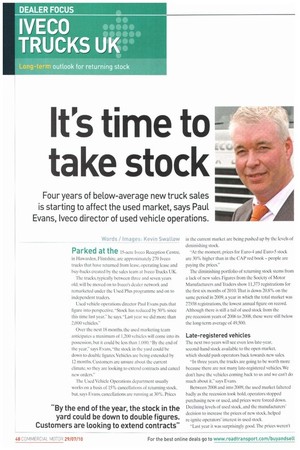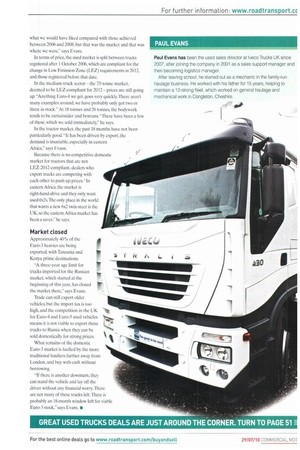It's time to take stock
Page 48

Page 49

If you've noticed an error in this article please click here to report it so we can fix it.
Four years of below-average new truck sales is starting to affect the used market, says Paul Evans, Iveco director of used vehicle operations.
Words / Images: Kevin Swallow Parked at the 15-acre Iveco Reception Centre, in Hawarden, Flintshire, are approximately 270 Iveco trucks that have returned from lease, operating lease and buy-backs created by the sales team at Iveco Trucks UK.
l'he trucks, typically between three and seven years old, will be moved on to Iveco's dealer network and remarketed under the Used Plus programme and on to independent traders.
Used vehicle operations director Paul Evans puts that figure into perspective. Stock has reduced by 50% since this time last year." he says."Last year we did more than 2,000 vehicles."
Over the next 18 months, the used marketing team anticipates a maximum of 1200 vehicles will come into its possession, but it could be less than 1.000."By the end of the year," says Evans,"the stock in the yard could be down to double figures. Vehicles are being extended by 12 months. Customers are unsure about the current climate, so they are looking to extend contracts and cancel new orders."
The Used Vehicle Operations department usually works on a basis of 15% cancellations of returning stock, but, says Evans. cancellations are running at 30%. Prices in the current market are being pushed up by the levels of diminishing stock.
"At the moment, prices for Euro-4 and Euro-5 stock are 30% higher than in the CAP red hook — people are paying the prices."
The diminishing portfolio of returning stock stems from a lack of new sales. Figures from the Society of Motor Manufacturers and Traders show 11,373 registrations for the first six months of 2010.That is down 20.8% on the same period in 2009, a year in which the total market was 27,938 registrations, the lowest annual figure on record. Although there is still a tail of used stock from the pre-recession years of 2006 to 2008, these were still below the long-term average of 49.500.
Late-registered vehicles
The next two years will see even less late-year. second-hand stock available to the open market. which should push operators back towards new sales.
"In three years, the trucks are going to he worth more because there are not many late-registered vehicles. We don't have the vehicles coming back to us and we can't do much about it," says Evans.
Between 2008 and into 2009, the used market faltered badly as the recession took hold, operators stopped purchasing new or used, and prices were forced down. Declining levels of used stock, and the manufacturers' decision to increase the prices of new stock, helped re-ignite operators' interest in used stock.
"Last year it was surprisingly good. The prices weren't what we would have liked compared with those achieved between 2006 and 2008. but that was the market and that was where we were," says Evans.
In terms of price, the used market is split between trucks registered after 1 October 2006, which are compliant for the change in Low Emission Zone (LEZ) requirements in 2012. and those registered before that date.
In the medium-truck sector the 7.5-tonne market, deemed to be LEZ-compliant for 2012prices are still going up. -Anything Euro-4 we get, goes very quickly. There aren't many examples around, we have probably only got two or three in stock." At 18 tonnes and 26 tonnes, the bodywork tends to be curtainsider and boxvans."There have been a few of these, which we sold immediately," he says In the tractor market, the past 18 months have not been particularly good. "It has been driven by export, the demand is insatiable, especially in eastern Africa," says Evans Because there is no competitive domestic market for tractors that arc not LEZ-2012-compliant. dealers who export trucks are competing with each other to push up prices in eastern Africa, the market is right-hand-drive and they only want used 6x2s.The only place in the world that wants a new 6x2 twin-steer is the UK, so the eastern Africa market has been a saver," he says
Market closed
Approximately .40% of the Euro-3 heavies are being exported, with Tanzania and Kenya prime destinations.
-A three-year age limit for trucks imported for the Russian market, which started at the beginning of this year, has closed the market there," says Evans.
Trade can still export older vehicles, but the import tax is too high, and the competition in the UK for Euro-4 and Euro-5 used vehicles means it is not viable to export these trucks to Russia when they can be sold domestically for strong prices What remains of the domestic Ettro-3 market is fuelled by the more traditional hauliers further away from London, and buy with cash without borrowing.
"If there is another downturn, they can stand the vehicle and lay off the driver without any financial worry There are not many of these trucks left.There is probably an 18-month window left for viable Euro-3 stock," says Evans. •




























































































































